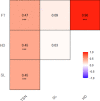Linkage mapping identifies a non-synonymous mutation in FLOWERING LOCUS T (FT-B1) increasing spikelet number per spike
- PMID: 33452357
- PMCID: PMC7811022
- DOI: 10.1038/s41598-020-80473-0
Linkage mapping identifies a non-synonymous mutation in FLOWERING LOCUS T (FT-B1) increasing spikelet number per spike
Abstract
Total spikelet number per spike (TSN) is a major component of spike architecture in wheat (Triticum aestivum L.). A major and consistent quantitative trait locus (QTL) was discovered for TSN in a doubled haploid spring wheat population grown in the field over 4 years. The QTL on chromosome 7B explained up to 20.5% of phenotypic variance. In its physical interval (7B: 6.37-21.67 Mb), the gene FLOWERING LOCUS T (FT-B1) emerged as candidate for the observed effect. In one of the parental lines, FT-B1 carried a non-synonymous substitution on position 19 of the coding sequence. This mutation modifying an aspartic acid (D) into a histidine (H) occurred in a highly conserved position. The mutation was observed with a frequency of ca. 68% in a set of 135 hexaploid wheat varieties and landraces, while it was not found in other plant species. FT-B1 only showed a minor effect on heading and flowering time (FT) which were dominated by a major QTL on chromosome 5A caused by segregation of the vernalization gene VRN-A1. Individuals carrying the FT-B1 allele with amino acid histidine had, on average, a higher number of spikelets (15.1) than individuals with the aspartic acid allele (14.3) independent of their VRN-A1 allele. We show that the effect of TSN is not mainly related to flowering time; however, the duration of pre-anthesis phases may play a major role.
Conflict of interest statement
On behalf of all authors, Jonathan Brassac states that there is no conflict of interest. J.P. and M.W.G. are members of the company TraitGenetics GmbH. This does, however, in no way limit the availability or sharing of data and materials.
Figures






Similar articles
-
Fine-tuning of heading time by earliness per se effect due to multi-allelic variants in VRN-B3 locus of hexaploid wheat.Planta. 2025 Mar 28;261(5):97. doi: 10.1007/s00425-025-04674-5. Planta. 2025. PMID: 40153070
-
TaAPO-A1, an ortholog of rice ABERRANT PANICLE ORGANIZATION 1, is associated with total spikelet number per spike in elite European hexaploid winter wheat (Triticum aestivum L.) varieties.Sci Rep. 2019 Sep 25;9(1):13853. doi: 10.1038/s41598-019-50331-9. Sci Rep. 2019. PMID: 31554871 Free PMC article.
-
Heading Date QTL in Winter Wheat (Triticum aestivum L.) Coincide with Major Developmental Genes VERNALIZATION1 and PHOTOPERIOD1.PLoS One. 2016 May 10;11(5):e0154242. doi: 10.1371/journal.pone.0154242. eCollection 2016. PLoS One. 2016. PMID: 27163605 Free PMC article.
-
Genome-wide association study of heading and flowering dates and construction of its prediction equation in Chinese common wheat.Theor Appl Genet. 2018 Nov;131(11):2271-2285. doi: 10.1007/s00122-018-3181-8. Epub 2018 Sep 14. Theor Appl Genet. 2018. PMID: 30218294 Review.
-
Identification of eight QTL controlling multiple yield components in a German multi-parental wheat population, including Rht24, WAPO-A1, WAPO-B1 and genetic loci on chromosomes 5A and 6A.Theor Appl Genet. 2021 May;134(5):1435-1454. doi: 10.1007/s00122-021-03781-7. Epub 2021 Mar 12. Theor Appl Genet. 2021. PMID: 33712876 Free PMC article.
Cited by
-
TaFT-D1 positively regulates grain weight by acting as a coactivator of TaFDL2 in wheat.Plant Biotechnol J. 2025 Jun;23(6):2207-2223. doi: 10.1111/pbi.70032. Epub 2025 Mar 18. Plant Biotechnol J. 2025. PMID: 40100647 Free PMC article.
-
Advancing understanding of oat phenology for crop adaptation.Front Plant Sci. 2022 Oct 14;13:955623. doi: 10.3389/fpls.2022.955623. eCollection 2022. Front Plant Sci. 2022. PMID: 36311119 Free PMC article. Review.
-
Chromosome-scale reference genome of an ancient landrace: unveiling the genetic basis of seed weight in the food legume crop pigeonpea (Cajanus cajan).Hortic Res. 2024 Jul 30;11(9):uhae201. doi: 10.1093/hr/uhae201. eCollection 2024 Sep. Hortic Res. 2024. PMID: 39257540 Free PMC article.
-
Identification and characterization of a natural polymorphism in FT-A2 associated with increased number of grains per spike in wheat.Theor Appl Genet. 2022 Feb;135(2):679-692. doi: 10.1007/s00122-021-03992-y. Epub 2021 Nov 26. Theor Appl Genet. 2022. PMID: 34825926 Free PMC article.
-
Identification and validation of two major QTL for grain number per spike on chromosomes 2B and 2D in bread wheat (Triticum aestivum L.).Theor Appl Genet. 2024 Jun 4;137(7):147. doi: 10.1007/s00122-024-04652-7. Theor Appl Genet. 2024. PMID: 38834870
References
-
- Pretini N, et al. A comprehensive study of spike fruiting efficiency in wheat. Crop Sci. 2020;60:1541–1555. doi: 10.1002/csc2.20143. - DOI
Publication types
MeSH terms
Substances
LinkOut - more resources
Full Text Sources
Other Literature Sources
Miscellaneous

